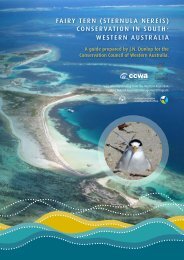Plant Bayside
7sHUbraIB
7sHUbraIB
You also want an ePaper? Increase the reach of your titles
YUMPU automatically turns print PDFs into web optimized ePapers that Google loves.
Habitat Gardening<br />
One of the many benefits of indigenous plants is that they can attract<br />
a large range of wildlife, including insects, birds and lizards. With<br />
some thoughtful design, you may be surprised at the types of<br />
animals you can attract to your garden, even in suburban areas.<br />
Select a variety of plants to create<br />
a complex and natural structure,<br />
including large trees, small and large<br />
shrubs, groundcovers, grasses and<br />
sedges. <strong>Plant</strong>s that produce flowers<br />
and seeds provide food for many of<br />
our native birds and mammals, whilst<br />
prickly shrubs provide them with a<br />
refuge in which to build their homes<br />
or escape from predators. Dense<br />
prickly shrubs and mature trees such<br />
as Acacia verticillata (Prickly Moses)<br />
and Leptospermum continentale<br />
(Prickly Tea-tree) can provide homes<br />
for a large range of insect, bird and<br />
mammal species.<br />
Dead trees and shrubs can also provide<br />
habitat for many of our native fauna.<br />
Take notice of any wildlife that visits<br />
your garden before you remove any<br />
dead trees or shrubs, as they may be<br />
providing a source of food or habitat.<br />
In addition to dead shrubs and trees,<br />
leaving a few logs (particularly those<br />
containing hollows), sticks and leaves on<br />
the ground can provide habitat for many<br />
local insects and lizards.<br />
Attracting birds<br />
Australia has a rich and diverse range of bird species found nowhere else in the<br />
world. Indigenous gardens provide a safe haven for our native birds. Many bird<br />
species will prey on garden pests such as caterpillars and aphids, contributing to<br />
non-chemical pest control in the garden. To create a bird-attracting garden consider<br />
the following points.<br />
Shelter<br />
Water<br />
Birds need shelter from predators such<br />
as cats and Noisy Miners. By providing<br />
prickly or dense plants at various levels<br />
in your garden you can provide a safe<br />
place for them to retreat to and create<br />
nesting sites.<br />
Hedge Wattle<br />
A reliable water source, particularly<br />
in summer, will attract birds to your<br />
garden. A birdbath on a pedestal next to<br />
a dense or prickly shrub will help birds<br />
feel secure.<br />
Birdbath<br />
Bird Icons<br />
The following bird icons appear in the Indigenous <strong>Plant</strong> List pages 28-60. The icon appears<br />
with those plants that provide food or shelter for different bird groups.<br />
Honeyeaters<br />
such as Spinebills,<br />
Wattlebirds and<br />
Honeyeaters<br />
Large Birds<br />
such as owls, Tawny<br />
Frogmouth and<br />
Kookaburras.<br />
Small Birds<br />
such as Wrens,<br />
Robins and Fantails<br />
Parrots<br />
such as Rosellas,<br />
Lorikeets and<br />
Cockatoos<br />
10 Live <strong>Bayside</strong> <strong>Plant</strong> <strong>Bayside</strong><br />
Live <strong>Bayside</strong> <strong>Plant</strong> <strong>Bayside</strong> 11



